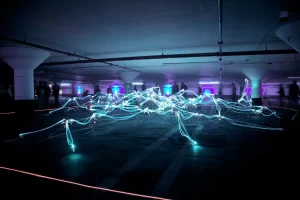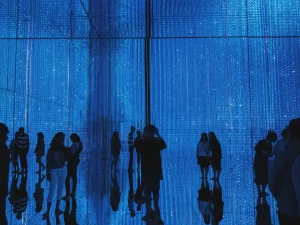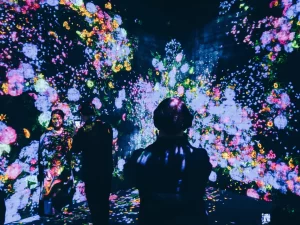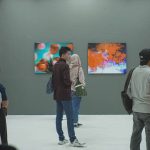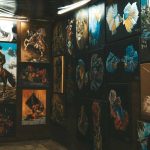Introduction to Digital Art Exhibitions
Introduction
Imagine stepping into a virtual realm where vibrant colors and dynamic shapes surround you as your interaction with art goes beyond the physical. This is the captivating experience offered by digital art exhibitions, redefining how we encounter and engage with artistic expressions. In the contemporary art world, these exhibitions are gaining prominence, challenging traditional displays and leveraging technology to innovate the landscape.
In this digital space, artists have the freedom to transcend conventional boundaries, experimenting with immersive installations, interactive pieces, and multimedia presentations that push the limits of creativity. Visitors can navigate through these virtual environments, often created using advanced computer graphics and virtual reality technologies, allowing for a truly immersive and personalized encounter with the artworks. The fusion of technology and artistic expression in these digital art exhibitions opens up new possibilities for artists to convey their messages, evoke emotions, and explore unconventional mediums.
Furthermore, the accessibility of digital art exhibitions breaks down geographical barriers, enabling individuals from around the world to participate in the cultural dialogue without the constraints of physical distance. This democratization of art fosters a global community of art enthusiasts who can explore, appreciate, and discuss innovative works collectively. As these virtual exhibitions continue to evolve, they not only redefine the traditional gallery experience but also contribute to the ongoing evolution of the art world, showcasing the transformative power of technology in shaping our perception and appreciation of artistic endeavors.
The Evolving Landscape of Art
As art evolves, digital mediums play an increasingly pivotal role in shaping creative expression. We witness a shift in artistic trends as the rise of digital art reflects a paradigm change in the way artists communicate and audiences perceive narratives. Digital exhibitions break down barriers, making art accessible to a global audience, and innovative technologies open doors for artists to explore new realms, pushing the boundaries of traditional artistic expression. The lines between physical and digital spaces are fading, creating immersive art experiences that merge the tangible and virtual realms, enhancing the overall impact of artistic expression.
Digital Renaissance
In the contemporary art scene, we are witnessing a digital renaissance where artists harness the power of technology to redefine the canvas of creative possibilities. The rise of digital art, ranging from computer-generated imagery (CGI) to virtual reality installations, signifies a departure from conventional artistic methods. This digital evolution is not merely a tool; it is a medium that introduces new aesthetics, challenging the established norms of the art world.
Democratizing Art Access
Digital exhibitions act as catalysts for democratizing art access. No longer confined to physical gallery spaces, art becomes a global phenomenon accessible to anyone with an internet connection. This accessibility revolutionizes the relationship between artists and audiences, fostering a more inclusive and diverse artistic landscape. As the barriers to entry diminish, emerging and established artists alike find platforms to share their creations with a worldwide audience.
Technological Innovation
Innovative technologies become the palette for artists exploring new realms of creativity. Augmented reality (AR), virtual reality (VR), and artificial intelligence (AI) are not just tools but collaborators in the artistic process. Artists leverage these technologies to craft immersive experiences, where viewers can interact with art on unprecedented levels. This synergy between art and technology fuels experimentation, pushing the boundaries of what is conceivable in artistic expression.
Blurring Physical and Digital Realms
The traditional distinctions between physical and digital spaces are fading. Immersive experiences, facilitated by digital exhibitions and interactive technologies, create seamless transitions between the tangible and virtual realms. Viewers find themselves navigating through a multi-dimensional art landscape where the boundaries between the physical and digital are blurred. This integration enhances the emotional and intellectual impact of artistic narratives, inviting audiences to participate in the creation of meaning.
Enhancing Artistic Impact
As the digital landscape evolves, artists are exploring ways to enhance the impact of their work. Multimedia presentations, interactive installations, and collaborative virtual experiences become avenues for artists to engage with their audience on a deeper level. The fusion of visual, auditory, and interactive elements creates a holistic artistic encounter that transcends the traditional confines of static art forms.
Diverse Formats of Digital Art Exhibitions
Digital art exhibitions come in various formats, each offering a unique experience. Immersive projections transform spaces into interactive and dynamic art environments, engaging viewers on a sensory level. Virtual galleries, powered by VR and AR experiences, redefine the gallery space, allowing viewers to explore digital realms and experience exhibitions from the comfort of their homes. Interactive installations invite viewers to actively contribute to the art, fostering co-creation and making the audience an integral part of the artistic process. Online platforms, such as curated shows and digital marketplaces, democratize access to art, connecting creators with a global audience.
Immersive Projections: Sensory Art Environments
Immersive projections redefine physical spaces, transforming them into interactive and dynamic art environments. Through advanced projection mapping techniques, artists can manipulate the perception of surfaces, creating a multi-sensory experience that goes beyond traditional static displays. Viewers find themselves surrounded by moving images and vibrant colors, immersed in a captivating fusion of visual and spatial elements that challenge conventional modes of artistic presentation.
Virtual Galleries: Redefining the Exhibition Space
Virtual galleries, powered by VR and AR experiences, redefine the traditional notion of gallery spaces. These digital environments enable viewers to explore curated exhibitions from the comfort of their homes. Navigating through these virtual realms, audiences can engage with artworks in three-dimensional spaces, gaining a sense of scale and presence. The flexibility of virtual galleries transcends physical limitations, offering a borderless experience where art can be encountered in innovative and personalized ways.
Interactive Installations: Co-Creation in Art
Interactive installations invite viewers to actively contribute to the artistic experience. These installations go beyond passive observation, encouraging audience participation and co-creation. Through touch, motion sensors, or other interactive elements, viewers become collaborators in the artistic process. The boundaries between artist and audience blur as individuals shape and influence the unfolding narrative of the artwork. This interactive dialogue fosters a sense of agency and connection, making the audience an integral part of the artistic journey.
Online Platforms: Democratizing Art Access
Online platforms, including curated shows and digital marketplaces, democratize access to art. These platforms provide a global stage for artists to showcase their work, reaching audiences far beyond traditional gallery spaces. Curated shows bring together diverse works under thematic umbrellas, offering viewers curated experiences that transcend geographical boundaries. Digital marketplaces provide a direct link between artists and collectors, facilitating the exchange of digital artworks and expanding the possibilities for artists to monetize their creations.
In embracing these diverse formats, digital art exhibitions are breaking away from traditional constraints, redefining how art is experienced, shared, and valued. From immersive sensory environments to virtual realms accessible worldwide, each format contributes to the rich tapestry of digital art, where innovation knows no bounds, and creativity unfolds in unexpected dimensions.
Benefits and Impact of Digital Exhibitions
Digital exhibitions bring forth a multitude of benefits, shaping the art landscape in profound ways. They democratize art by breaking down geographical barriers, offering artists exposure to diverse audiences globally. Moreover, the reduced environmental footprint of digital exhibits contributes to a more sustainable art world compared to traditional shows. Digital exhibitions also open up new revenue streams for artists through online sales and interactive features. Beyond aesthetics, these exhibits spark dialogue, critical thinking, and deeper audience engagement, creating a dynamic relationship between the art and its viewers.
Democratizing Art: Global Exposure and Accessibility
Digital exhibitions serve as a powerful tool for democratizing art by breaking down geographical barriers. Artists can showcase their work to a global audience without the limitations of physical locations. This increased accessibility provides exposure to diverse cultural contexts, fostering a more inclusive and interconnected art community. Viewers from different parts of the world can engage with artworks, contributing to a rich tapestry of global artistic dialogue.
Reduced Environmental Footprint: Towards a Sustainable Art World
The environmental impact of traditional art exhibitions, involving transportation, materials, and energy consumption, is a growing concern. Digital exhibitions contribute to a more sustainable art world by significantly reducing the carbon footprint associated with traditional shows. The virtual nature of these exhibits eliminates the need for physical transportation of artworks and the construction of exhibition spaces, aligning with the global push towards eco-friendly practices in the arts.
New Revenue Streams: Online Sales and Interactivity
Digital exhibitions open up new revenue streams for artists through online sales and interactive features. Online platforms enable artists to sell digital versions of their work directly to collectors, eliminating the need for intermediaries. Interactive features, such as augmented reality experiences or virtual galleries with purchasing capabilities, provide unique opportunities for artists to monetize their creations and connect with a global market, diversifying their income sources.
Engagement and Dialogue: Fostering Deeper Connections
Beyond aesthetics, digital exhibitions spark dialogue, critical thinking, and deeper audience engagement. Viewers can interact with artworks in innovative ways, contributing to a more dynamic relationship between the art and its audience. Social media integration, live chats, and virtual discussions create a space for conversations around the exhibited works, enhancing the overall experience. This interconnected engagement fosters a sense of community and shared exploration of artistic expressions.
Dynamic Relationship between Art and Audience
Digital exhibitions redefine the relationship between art and audience. Viewers are not mere spectators but active participants in the artistic experience. The interactive nature of digital exhibits encourages exploration, interpretation, and personal connection with artworks. This dynamic relationship transforms the way audiences perceive and engage with art, making the artistic encounter more personal and immersive.
The Future of Digital Art Exhibitions
Looking ahead, the future of digital art exhibitions holds exciting possibilities. Emerging technologies, including AI and blockchain, are expected to enrich the immersive experience of these exhibitions, pushing the boundaries of artistic innovation. The role of curators evolves as they navigate the digital landscape, curating experiences that transcend physical constraints. The ongoing integration of physical and digital elements in art exhibitions points towards a continued hybridity, redefining how we perceive and interact with art.
Integration of AI: Enriching Immersive Experiences
The future of digital art exhibitions is poised to be enriched by the integration of artificial intelligence (AI). AI can enhance the immersive experience by offering personalized interactions based on individual preferences and reactions. Machine learning algorithms can analyze audience engagement data, providing valuable insights for artists and curators to tailor future exhibitions. AI-generated art, collaborative projects between artists and AI, and interactive installations driven by intelligent algorithms contribute to a dynamic and evolving digital art landscape.
Blockchain in Art: Ensuring Authenticity and Ownership
Blockchain technology is anticipated to play a pivotal role in the future of digital art exhibitions, addressing issues of authenticity and ownership. Blockchain provides a secure and transparent way to verify the authenticity of digital artworks, ensuring the provenance of each piece. Smart contracts embedded in blockchain technology enable artists to retain ownership and receive fair compensation through transparent and automated royalty payments. This decentralized approach disrupts traditional models of art distribution and ownership, empowering artists in the digital realm.
Evolution of Curatorial Practices: Navigating the Digital Landscape
The role of curators in digital art exhibitions evolves as they navigate the vast and dynamic digital landscape. Curators become orchestrators of experiences, curating not only individual artworks but also the overall immersive journey for the audience. The curation of digital exhibitions involves considerations of interactive elements, user experience design, and the seamless integration of diverse technologies. Curators become facilitators of meaningful connections between the audience and the artworks, curating narratives that transcend physical and digital boundaries.
Hybrid Exhibitions: Integrating Physical and Digital Realms
The integration of physical and digital elements in art exhibitions is a trend that will likely continue to define the future. Hybrid exhibitions blend traditional gallery spaces with virtual environments, offering viewers a multi-dimensional experience. Physical artworks coexist with digital installations, creating a dynamic interplay between tangible and virtual realities. This hybrid approach expands the possibilities for artistic expression, encouraging artists to explore the synergies between physical and digital mediums.
Expanded Accessibility and Global Collaboration
The future of digital art exhibitions promises expanded accessibility and global collaboration. Advanced technologies will enable more people to engage with art regardless of their geographical location. Virtual reality (VR), augmented reality (AR), and other immersive technologies will provide increasingly realistic and interactive experiences, bringing global audiences together in shared virtual spaces. This global accessibility fosters collaboration among artists, curators, and audiences, contributing to a more interconnected and collaborative artistic community.
Conclusion
In conclusion, digital art exhibitions significantly contribute to diversifying the art scene and offer unique opportunities for both artists and audiences. Their impact on the cultural landscape is undeniable, and as we explore the realm of digital art exhibitions, we open ourselves to transformative possibilities. This article encourages readers to actively engage with digital art and embrace the unique opportunities presented by these exhibitions.
Key Takeaway
| Aspect | Key Takeaway |
| Evolution of Art | Digital mediums redefine creative expression. |
| Accessibility and Innovation | Digital exhibitions break barriers, fostering innovation. |
| Diverse Formats | Immersive projections, virtual galleries, interactive installations, and online platforms redefine art experiences. |
| Benefits and Impact | Democratization, sustainability, new revenue streams, and increased engagement reshape the art landscape. |
| Future Trends | Emerging technologies, evolving curation, and continued hybridity point towards a dynamic future for digital art exhibitions. |
FAQs
How do digital art exhibitions differ from traditional displays?
Digital art exhibitions leverage technology to redefine the way we encounter and engage with art, moving beyond the physical constraints of traditional displays. They often incorporate immersive experiences, virtual reality, and interactive elements, challenging conventional artistic expression.
What are the environmental benefits of digital exhibitions?
Digital exhibitions contribute to sustainability by minimizing the environmental footprint associated with traditional art shows. The efficiency of digital formats reduces resource consumption, making them a more eco-friendly option.
How can artists benefit from participating in digital exhibitions?
Digital exhibitions democratize art by breaking down geographical barriers, offering artists exposure to global audiences. Additionally, artists can explore new revenue streams through online sales and interactive features.
What role does technology play in the future of digital art exhibitions?
Emerging technologies such as AI and blockchain are expected to enrich the immersive experience of digital art exhibitions. They will push the boundaries of artistic innovation, creating new possibilities for both artists and audiences.
How can individuals actively engage with digital art exhibitions?
Individuals can actively engage with digital art exhibitions by exploring online platforms, participating in virtual experiences, and embracing the interactive elements offered by these exhibitions. Being open to the unique opportunities presented by digital art is key to a fulfilling engagement.



